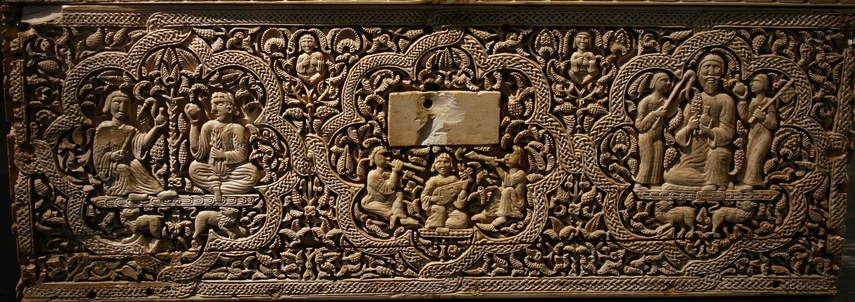
Find the perfect fit with Amazon Prime. Try Before You Buy.

This ivory casket was made for ‘Abd al-Malik al-Muzaffar and seems to have been commissioned to celebrate his victory of 1004-1005 over the kingdom of León, obtaining thus the caliphate of Hishâm II and the title of Sayf al-Dawla (‘Sabre of the State’). The presence of different signatures on the piece, the various compositions and the overall style firmly indicate that this is a product of a royal workshop. The casket has been built out of different sculpted panels joined together. Rectangular in shape, it has a truncated pyramidal lid. An uninterrupted plaited ribbon encloses twenty-one medallions: thirteen on the lid and eight on the body of the casket. The medallions are interlaced with vegetal motifs interspersed with birds, animals and figures.

The central medallions on the front panel of the lid represent horsemen-hunters. The medallions on either side of these two scenes contain two animals in combat: lions clutching gazelles.

The three medallions on the front of the body present scenes from courtly life. On the one to the right, a bare headed, bearded figure with moustache is seated on a throne that rests on two lions. The central medallion presents three musicians, seated and playing the lute, a horn and a double flute. On the left medallion, two men are seated on a throne that rests on two lions, intertwined with a stylized vegetal motif.

The central medallions on the back panel of the lid represent warriors on horse-sized elephants. The medallions on either side of these contain two animals in combat: a frontal view of an eagle whose claws have caught two quadrupeds.

The back of the casket is taken up in its centre by a medallion decorated with a hunter defending himself with a shield against two lions. Fighting scenes take up the two flanking medallions.
The casket was used during a number of centuries in the Leyre Monastery to store relics of the saints Nunilona and Alodia. Afterwards it was transferred to the church of S. María la Real de Sigüenza and then to the treasury of the Pamplona Cathedral.
Reference: Qantara
Picture source: photos by Ray Escámez Rivero
Museo de Pamplona (Navarra). Arqueta de Leyre
Referenced as figure 497 in The military technology of classical Islam by D Nicolle
497. Ivory box inscribed to ʿAbd al Malik at Muzaffar, 1005 AD, Andalusian, Cathedral Treasury, Pamplona (Beck).